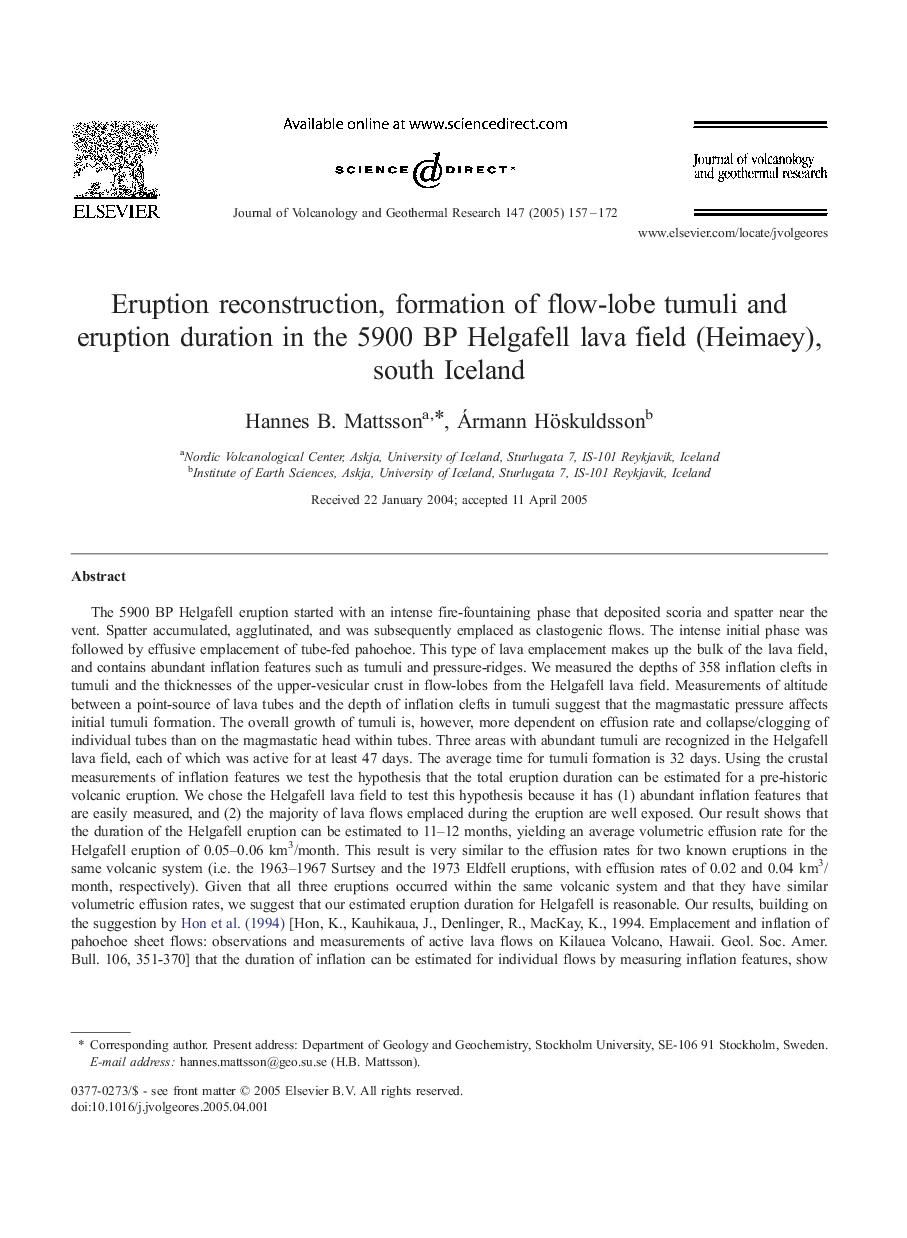| کد مقاله | کد نشریه | سال انتشار | مقاله انگلیسی | نسخه تمام متن |
|---|---|---|---|---|
| 9531659 | 1638491 | 2005 | 16 صفحه PDF | دانلود رایگان |
عنوان انگلیسی مقاله ISI
Eruption reconstruction, formation of flow-lobe tumuli and eruption duration in the 5900 BP Helgafell lava field (Heimaey), south Iceland
دانلود مقاله + سفارش ترجمه
دانلود مقاله ISI انگلیسی
رایگان برای ایرانیان
کلمات کلیدی
موضوعات مرتبط
مهندسی و علوم پایه
علوم زمین و سیارات
ژئوشیمی و پترولوژی
پیش نمایش صفحه اول مقاله

چکیده انگلیسی
The 5900 BP Helgafell eruption started with an intense fire-fountaining phase that deposited scoria and spatter near the vent. Spatter accumulated, agglutinated, and was subsequently emplaced as clastogenic flows. The intense initial phase was followed by effusive emplacement of tube-fed pahoehoe. This type of lava emplacement makes up the bulk of the lava field, and contains abundant inflation features such as tumuli and pressure-ridges. We measured the depths of 358 inflation clefts in tumuli and the thicknesses of the upper-vesicular crust in flow-lobes from the Helgafell lava field. Measurements of altitude between a point-source of lava tubes and the depth of inflation clefts in tumuli suggest that the magmastatic pressure affects initial tumuli formation. The overall growth of tumuli is, however, more dependent on effusion rate and collapse/clogging of individual tubes than on the magmastatic head within tubes. Three areas with abundant tumuli are recognized in the Helgafell lava field, each of which was active for at least 47 days. The average time for tumuli formation is 32 days. Using the crustal measurements of inflation features we test the hypothesis that the total eruption duration can be estimated for a pre-historic volcanic eruption. We chose the Helgafell lava field to test this hypothesis because it has (1) abundant inflation features that are easily measured, and (2) the majority of lava flows emplaced during the eruption are well exposed. Our result shows that the duration of the Helgafell eruption can be estimated to 11-12 months, yielding an average volumetric effusion rate for the Helgafell eruption of 0.05-0.06 km3/month. This result is very similar to the effusion rates for two known eruptions in the same volcanic system (i.e. the 1963-1967 Surtsey and the 1973 Eldfell eruptions, with effusion rates of 0.02 and 0.04 km3/month, respectively). Given that all three eruptions occurred within the same volcanic system and that they have similar volumetric effusion rates, we suggest that our estimated eruption duration for Helgafell is reasonable. Our results, building on the suggestion by Hon et al. (1994) [Hon, K., Kauhikaua, J., Denlinger, R., MacKay, K., 1994. Emplacement and inflation of pahoehoe sheet flows: observations and measurements of active lava flows on Kilauea Volcano, Hawaii. Geol. Soc. Amer. Bull. 106, 351-370] that the duration of inflation can be estimated for individual flows by measuring inflation features, show that by combining abundant and measureable inflation features with a well-established stratigraphy the duration of an entire pre-historic eruption can be estimated.
ناشر
Database: Elsevier - ScienceDirect (ساینس دایرکت)
Journal: Journal of Volcanology and Geothermal Research - Volume 147, Issues 1â2, 1 October 2005, Pages 157-172
Journal: Journal of Volcanology and Geothermal Research - Volume 147, Issues 1â2, 1 October 2005, Pages 157-172
نویسندگان
Hannes B. Mattsson, Ármann Höskuldsson,